Survey creation using SurveyAccessor
Kaufmann, 2024-2025.
[1]:
from geometron.survey import SurveyAccessor, create_survey, TopoPoint, TopoLine
from geometron.geometries import transforms as ggt
from geometron.plot import plot_basemap
import matplotlib.pyplot as plt
import geopandas as gpd
from shapely.geometry import Point, LineString
import shapely
Create some landmarks in a local coordinate system
Coordinates are planar coordinates
Using wkt
[2]:
L001 = TopoPoint('POINT (0. 0.)', id='L001', kind='landmark')
L002 = TopoPoint('POINT (50. 0.)', id='L002', kind='landmark')
Using shapely geometries
[3]:
L003 = TopoPoint(Point(4., 120.), id='L003', kind='landmark')
L004 = TopoPoint(Point(54., 112.), id='L004', kind='landmark')
Plot L001 in a matplotlib axes
[4]:
L001.plot()

Add the landmarks in a new survey geodataframe and display the survey
[5]:
gdf, f_list = create_survey([L001, L002, L003, L004])
gdf
[{'type': 'Feature', 'properties': {'id': 'L001', 'class': 'TopoPoint', 'kind': 'landmark', 'label': 'L001', 'show_label': True}, 'geometry': {'type': 'Point', 'coordinates': (0.0, 0.0)}}, {'type': 'Feature', 'properties': {'id': 'L002', 'class': 'TopoPoint', 'kind': 'landmark', 'label': 'L002', 'show_label': True}, 'geometry': {'type': 'Point', 'coordinates': (50.0, 0.0)}}, {'type': 'Feature', 'properties': {'id': 'L003', 'class': 'TopoPoint', 'kind': 'landmark', 'label': 'L003', 'show_label': True}, 'geometry': {'type': 'Point', 'coordinates': (4.0, 120.0)}}, {'type': 'Feature', 'properties': {'id': 'L004', 'class': 'TopoPoint', 'kind': 'landmark', 'label': 'L004', 'show_label': True}, 'geometry': {'type': 'Point', 'coordinates': (54.0, 112.0)}}]
[5]:
| geometry | class | kind | label | show_label | |
|---|---|---|---|---|---|
| id | |||||
| L001 | POINT (0 0) | TopoPoint | landmark | L001 | True |
| L002 | POINT (50 0) | TopoPoint | landmark | L002 | True |
| L003 | POINT (4 120) | TopoPoint | landmark | L003 | True |
| L004 | POINT (54 112) | TopoPoint | landmark | L004 | True |
[6]:
gdf.survey.plot()
[6]:
<Axes: >
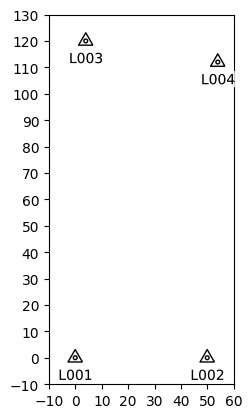
Create a baseline in local coordinates
Baseline B01 joins L001 and L002
[7]:
B01 = TopoLine(LineString([L001.geometry, L002.geometry]), id='B01', kind='baseline', show_label=False)
[8]:
B01.plot()
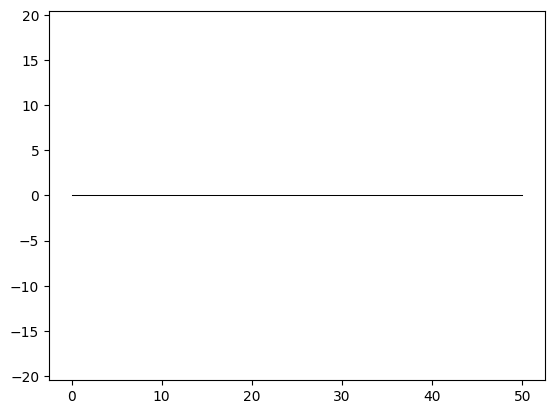
Baseline B02 joins L003 and L004
[9]:
B02 = TopoLine(LineString([L003.geometry, L004.geometry]), id='B02', kind='baseline', show_label=False)
Append the survey geodataframe
[10]:
gdf = gdf.survey.add_features([B01, B02])
Display the appended survey
[11]:
gdf.survey.plot()
[11]:
<Axes: >
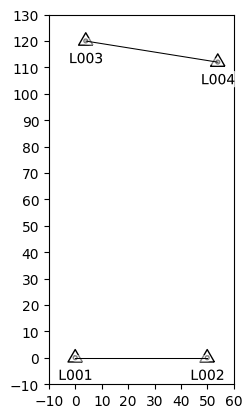
Add 18 meandering profiles starting and ending on the baselines
The distance between the starting and ending points along the baseline is set to 2 meters
[12]:
number_of_profiles = 18
spacing_on_B01 = 2
spacing_on_B02 = 2
Create the stakes where the profiles start and end
[13]:
stakes_B01 = [TopoPoint(Point(B01.geometry.interpolate(i*spacing_on_B01)), id='', kind='stake') for i in range(1, number_of_profiles+1)]
stakes_B02 = [TopoPoint(Point(B02.geometry.interpolate(i*spacing_on_B02)), id='', kind='stake') for i in range(1, number_of_profiles+1)]
Append the survey geodataframe and plot it
[14]:
gdf = gdf.survey.add_features(stakes_B01)
gdf = gdf.survey.add_features(stakes_B02)
[15]:
gdf.survey.plot()
[15]:
<Axes: >
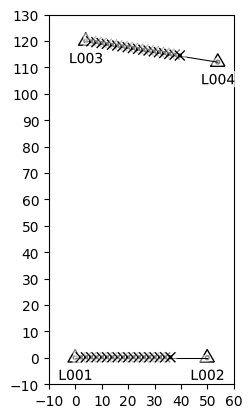
Create the profiles and append the survey geodataframe
[16]:
profiles = []
for i in range(1,number_of_profiles+1,2):
profiles.append(TopoLine(LineString([stakes_B01[i-1].geometry, stakes_B02[i-1].geometry]), id=f'P{i:02d}', kind='profile'))
for i in range(2,number_of_profiles+1,2):
profiles.append(TopoLine(LineString([stakes_B02[i-1].geometry, stakes_B01[i-1].geometry]), id=f'P{i:02d}', kind='profile'))
[17]:
gdf = gdf.survey.add_features(profiles)
[18]:
fig, ax = plt.subplots(figsize=(6,12))
gdf.survey.plot(ax=ax)
[18]:
<Axes: >
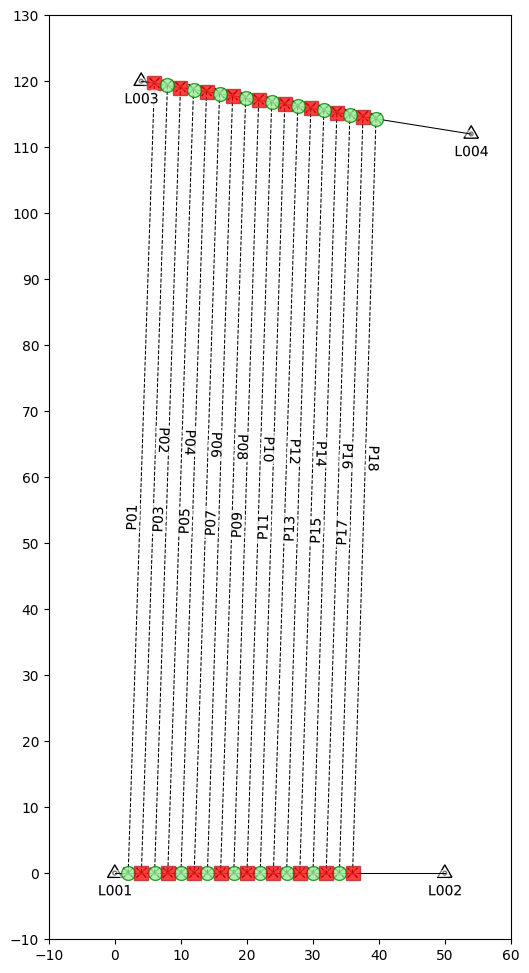
Transform from local coordinates to geographic coordinates
Here an affine transform is used. Based on the use case other approaches could be better suited.
Define the control points for the affine transform
[19]:
origin_coords = [L001, L002, L003, L004]
[20]:
landmarks = gpd.read_file('./data/landmarks.shp')
landmarks.set_index('Label', drop=False, inplace=True)
landmarks.crs
[20]:
<Projected CRS: EPSG:3812>
Name: ETRS89 / Belgian Lambert 2008
Axis Info [cartesian]:
- X[east]: Easting (metre)
- Y[north]: Northing (metre)
Area of Use:
- name: Belgium - onshore.
- bounds: (2.5, 49.5, 6.4, 51.51)
Coordinate Operation:
- name: Belgian Lambert 2008
- method: Lambert Conic Conformal (2SP)
Datum: European Terrestrial Reference System 1989 ensemble
- Ellipsoid: GRS 1980
- Prime Meridian: Greenwich
[21]:
destination_coords = [(i.x, i.y) for i in landmarks.loc[['L001', 'L002', 'L003', 'L004'], 'geometry'].values]
Compute the transform matrix
[22]:
matrix, residual, _, _ = ggt.affine_transform_matrix(origin_coords=origin_coords, destination_coords=destination_coords)
[23]:
residual
[23]:
array([1.70078765, 5.30641372])
Save the local coordinates in wkt format in the ‘local_geometry’ column and apply the transform to the survey geodataframe
[24]:
gdf['local_geometry'] = gdf['geometry'].to_wkt()
[25]:
gdf['geometry'] = gpd.GeoSeries.from_wkt(gdf['local_geometry']).affine_transform(matrix)
gdf.crs = landmarks.crs
Plot the transformed survey on a basemap
NOTE:
The survey geodataframe should be converted to WGS84 (epsg:4326) for display over a basemap created with geometron.plot.plot_basemap.
It should be located entirely within the extent of the basemap
Compute the extent of the map using a buffer around the survey geodataframe
[26]:
extent = gdf.buffer(10).to_crs('epsg:4326').total_bounds[[0,2,1,3]]
[27]:
cache_dir = './tmp_files/.tiles_cache'
Plot the basemap and the survey geodataframe
[28]:
ax = plot_basemap(extent, figsize=(12,12), xyz_server='google terrain', cache_dir=cache_dir, max_zoom=19)
gdf.to_crs('epsg:4326').survey.plot(ax=ax, grid='on')
[28]:
<Axes: >
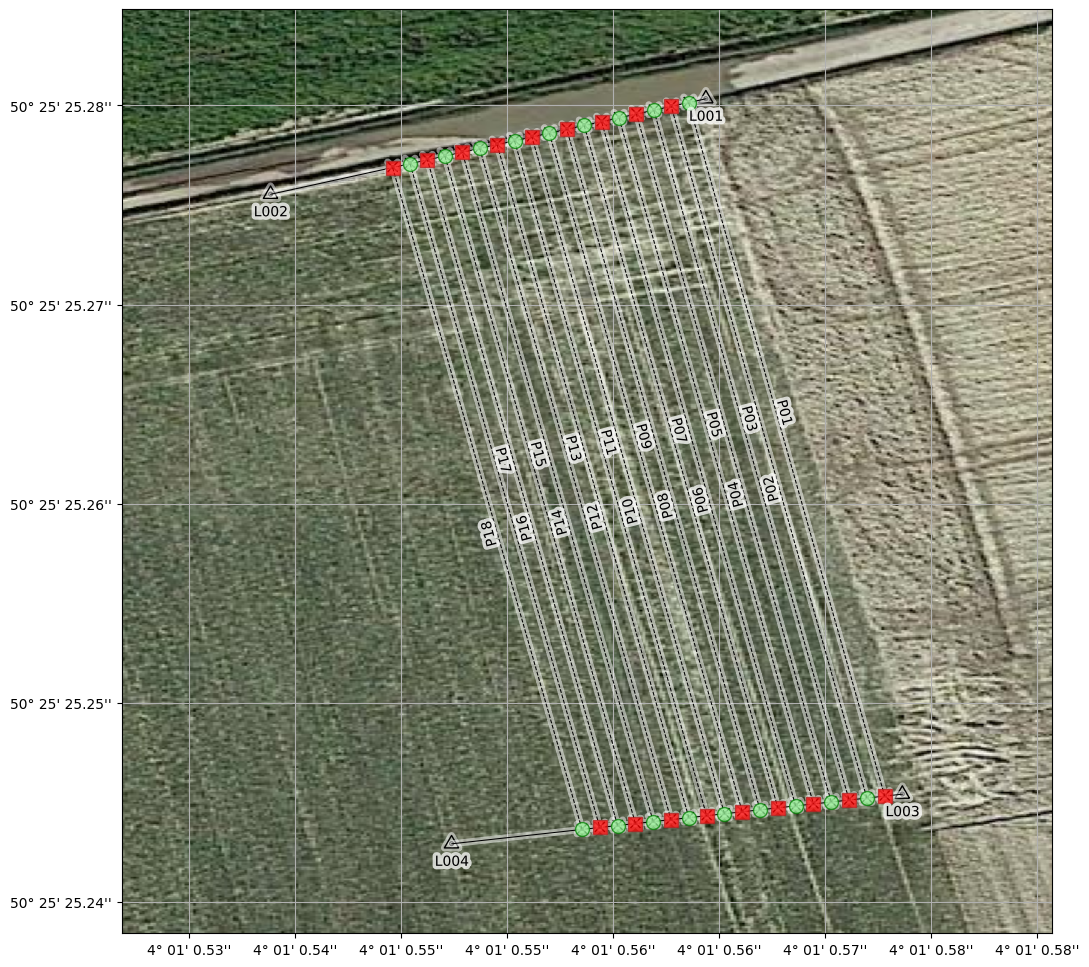
Export the survey geodataframe to a geopackage
[29]:
gdf.to_file('./tmp_files/survey.gpkg', driver='GPKG')